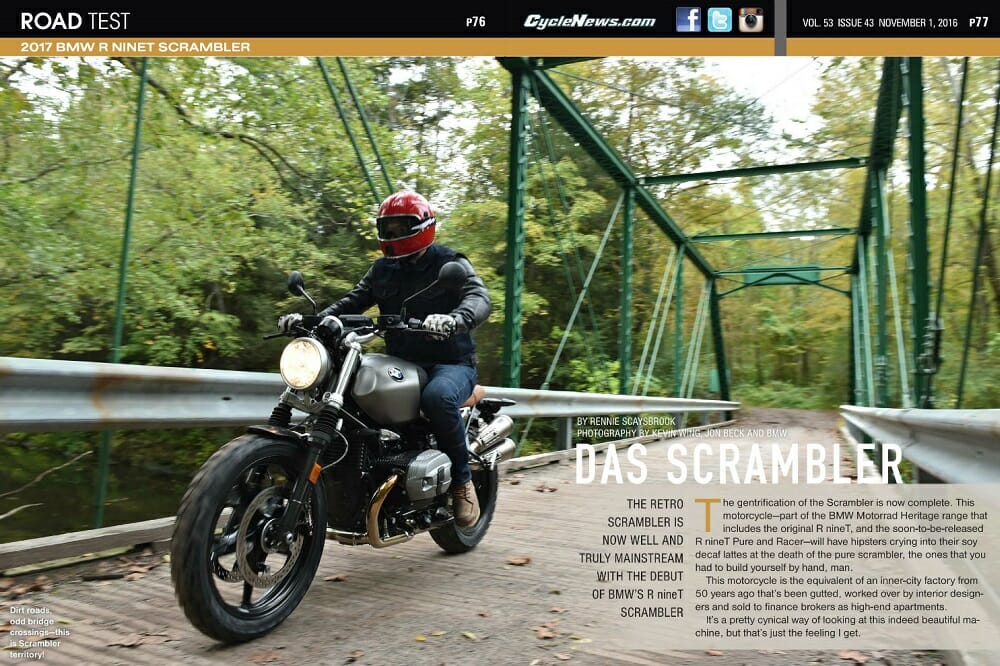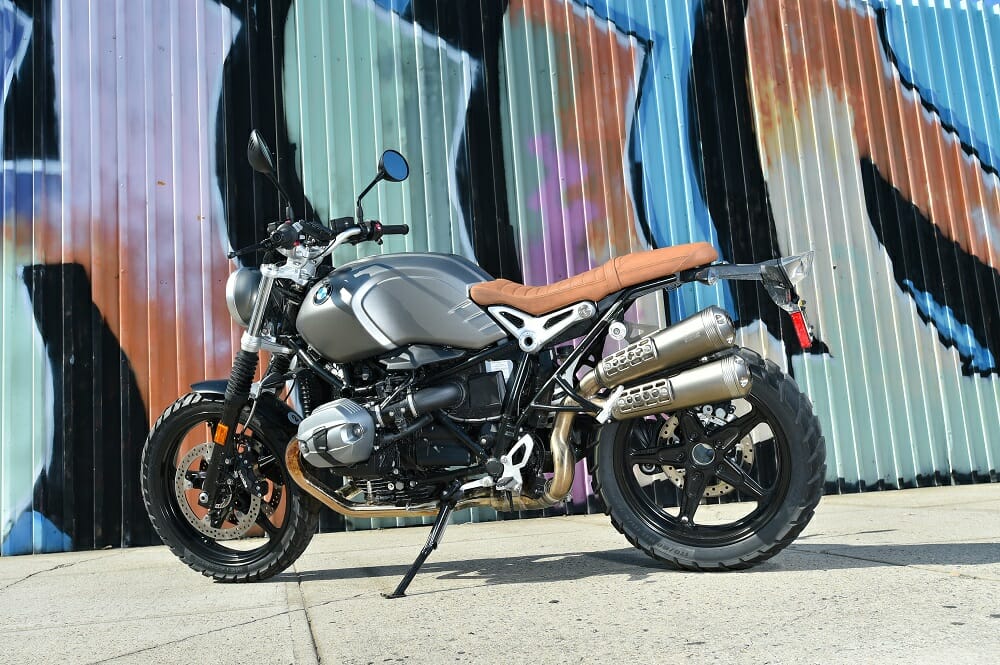Rennie Scaysbrook | November 2, 2016
The retro Scrambler is now well and truly mainstream with the debut of BMW’s R nineT Scrambler
The gentrification of the Scrambler is now complete. This motorcycle—part of the BMW Motorrad Heritage range that includes the original R nineT, and the soon-to-be-released R nineT Pure and Racer—will have hipsters crying into their soy decaf lattes at the death of the pure scrambler, the ones that you had to build yourself from hand, man.
 Dirt roads, odd bridge crossings—this is Scrambler territory!
Dirt roads, odd bridge crossings—this is Scrambler territory!
This motorcycle is the equivalent of an inner-city factory from 50 years ago that’s been gutted, worked over by interior designers and sold to finance brokers as high-end apartments.
It’s a pretty cynical way of looking at this indeed beautiful machine, but that’s just the feeling I get.

To read this in Cycle News Digital Edition, click HERE
Photography by Kevin Wing, Jon Beck and BMW
But I’m not being fair. This bike, resplendent in silver alloy and brown leather and single-sided swingarm beauty, is a real treat to the eye. When a manufacturer takes a concept that’s become popular in the custom crowd and tries to go mainstream with it, they can often lose sight of the ethos of the subject they’re trying to push. Often they are just accused of trying to find a new cash cow.
BMW has gone to great lengths to ensure the Scrambler captures that freedom vibe, that unshackled charisma which made the scrambler motorcycle such a legend in the first place—and also making sure you’ve got heated grips to keep your little mitts warm while channeling your inner Steve McQueen.
 Okay, Rennie. Blue steel—or was that Magnum?
Okay, Rennie. Blue steel—or was that Magnum?
They’ve had help from the custom crowd long before their R nineT Scrambler saw the light of day, as air-head BMWs have been flavor of the month/year/decade when it comes to custom bikes. Once considered an act against God to chop up, air-head Beemers have been finding their way to grinders the world over and some truly inspiring designs have resulted, so we shouldn’t be surprised BMW caught onto this and wanted a piece of the pie.
 The R nineT’s ergonomics are some of the best on the market today for taller riders
The R nineT’s ergonomics are some of the best on the market today for taller riders
Powering the R nineT Scrambler is an 1170cc air/oil-cooled boxer twin turning a six-speed gearbox. It’s the same combination first seen in the 2011 R 1200 GS and the same as the standard R nineT—the last of the pre-water-cooled generation and a true gem of an engine. The tubular steel space frame chassis is a similar one to the R nineT roadster—similar, but not the same. The Scrambler rolls with a 19-inch front wheel compared to the 17-incher found on the roadster, and as a result there’s visibly more space around the front wheel with 3° more rake and 0.32 inches more trail, all in the benefit of off-road stability and steering ease on the road.
 Rubber gaiters give a great look. Pity about fork performance.
Rubber gaiters give a great look. Pity about fork performance.
The gaiter-equipped forks—to the Scrambler’s detriment—are un-adjustable and out back there’s the standard BMW-style Paralever suspension, actuating a single shock absorber with preload and rebound damping adjustment at your fingertips.
Part of what makes the Scrambler the bike it is—aside from the obvious front wheel and that superlative (looks and comfort) seat—is the Supertrapp-style twin muffler that exits up the rear left of the bike. It’s not a true Supertrapp as the rear plates are not separate, instead they’re simply grooves in the single-piece aluminum mufflers, but hey, it’s all about the look, right?
 Supertrapp-style exhaust sounds and looks great despite not being a real Supertrapp.
Supertrapp-style exhaust sounds and looks great despite not being a real Supertrapp.
The Scrambler also comes with a lot of goodies the other mainstream Scramblers don’t, namely traction control and ABS, the aforementioned heated grips, and a basic dash computer and funky-looking analog tacho. The same front and rear brakes as the R nineT feature on the Scrambler equivalent.
But does it all work? Yes, for the most part.
Straddling the Scrambler, what is immediately apparent is the riding triangle of bars/seat/pegs is absolutely spot on for my 6’1” frame. The seat, while a touch thin, is padded really nicely and after an eight-hour epic ride on day one and a six-hour mission on day two of the test, I feel surprisingly fresh without the dreaded backache.
 That seat looks great and gives great long-distance comfort.
That seat looks great and gives great long-distance comfort.
There’s a definitely gruff note that comes from the muffler on start-up, one that reminds me of my old GS that had a Giannelli exhaust fitted. It’s a touch lower and fatter in the aural department at idle, but to be honest, after five minutes, I didn’t really notice the noise.
The engine, I feel, if you’re a regular Cycle News reader, is a known quantity. It’s the same flat twin found in not just that GS I mentioned but each R nineT, and also the R 1200 R and R 1200 RS. Debuting as the final GS motor before the Wasser-Boxer (water-boxer) engine of 2014, the 1170cc motor is perhaps BMW’s finest example of the air-cooled twin. Beautiful waves of thick torque come in droves. It doesn’t like big revs, instead giving its best performance sub-6000 rpm and I feel it’s a touch over-geared for the Scrambler.
I didn’t once see sixth gear during two days of testing, but there’s no denying it has stupendous torque and a delightfully smooth throttle response that makes the Scrambler a joy in tricky, tight riding situations on the trail or when lane-splitting through stopped traffic.
 Crank it over! Despite the non-standard knobby tires, you can really get into it on the Scrambler.
Crank it over! Despite the non-standard knobby tires, you can really get into it on the Scrambler.
However, I must address the white elephant in the room. The Showa front suspension is not up to the quality the rest of the machine exudes. This is one of the most expensive Scrambler-style bikes on the market today, as such I would have expected BMW to grace the machine with forks that offer far greater damping characteristics than what is currently on the R nineT Scrambler. The forks blow through the stroke and rebound back far too violently, and with no adjustment available, the rider just has to grin and bear it. The result is a wholly uncomfortable ride on anything other than very smooth roads.
The rear suspension isn’t fantastic, either, but it’s better than the front. The single shock absorber will soak up much more punishment before handing the vibrations to your body, but all-in-all the suspension lets what is otherwise a great bike down.
Despite this, the Scrambler is a joy on smooth, sweeping bends, and it’s not that bad off road, once you take the horridness of the suspension out of the equation. Our test bikes come in both the standard alloy wheel and optional spoked-wheel versions and are shod with the excellent Metzeler Karoo 3 tires, giving super steering response on and off road.
 Minimalist and easy to read, with all the information you need and none you don’t.
Minimalist and easy to read, with all the information you need and none you don’t.
At 485 pounds of claimed curb weight, it’s no Jenny Craig special, and you can’t treat it with the abandon of Steve McQueen running from the Nazis, but the R nineT Scrambler will play along on dirt roads while maintaining a certain amount of composure and letting you get your jollies. It’s actually quite good on road, but sharp-edge bumps are the bike’s nemesis and were I to go dumping $13,000 on one of these, I’d be going to a proper suspension shop to see what they could do for me, stat.
One of the things I struggle with in this whole mainstream scrambler concept (and this is not labeled at just BMW), is that traditional scramblers were made that way out of road bikes by their owners. That was the whole point of a scrambler—you make one your own out of something it wasn’t before. So to then be presented with a scrambler that’s ready to rock straight away, I can’t see too many people taking an angle grinder to it and totally making it their own because in essence, it’s already done for them.
 The changing colors of New Jersey go hand in hand with the changing landscape of motorcycle design. Man, that was deep.
The changing colors of New Jersey go hand in hand with the changing landscape of motorcycle design. Man, that was deep.
Don’t get me wrong, I’m no bike customizer and I’m more likely to buy a pre-made bike from BMW or Yamaha or Ducati than I am to take an R 1200 R and go custom mental on the thing, so maybe I am the target rider for BMW. Maybe I’m the suit wearer living in a revamped factory. Plus, with a price tag of $13 grand, I think the most customizing an R nineT Scrambler will get from the masses (not real bike builders), will be a trip to the sumptuously stocked BMW Motorrad accessory catalog. And that may not necessarily be a bad thing, considering how many poorly home-customized bikes we have riding around on our streets.
Regardless, the BMW R nineT Scrambler is at its base, a very good bike. The engine, chassis, ergonomics, and indeed the style are all top notch—the suspension must be improved—but the rest of the bike is quality and it certainly fills another notch in BMW’s ever-expanding line-up. CN

|
SPECIFICATIONS: 2017 BMW R nineT Scrambler
|
|
Engine:
|
Air/oil-cooled 2-cylinder boxer
|
|
Displacement:
|
1170cc
|
|
Bore x stroke:
|
101 x 73mm
|
|
Horsepower:
|
110 hp @ 7750 rpm (claimed)
|
|
Torque:
|
85 lb-ft @ 6000 rpm (claimed)
|
|
Compression ratio:
|
12.0:1
|
|
Fuel system:
|
EFI with 50mm throttle bodies
|
|
Exhaust:
|
2-into-2-into-1 layout, two oxygen sensors, lateral single silencer w/ ECU-controlled bypass valve and integrated catalytic converter (Euro 4).
|
|
Transmission:
|
6-speed
|
|
Chassis:
|
Tubular space frame in steel, engine self-supporting
|
|
Front suspension:
|
43mm inverted forks
|
|
Rear suspension:
|
Monoshock
|
|
Front wheel travel:
|
4.9 in.
|
|
Rear wheel travel:
|
5.5 in.
|
|
Front brake:
|
Dual 320mm discs, Brembo 4-piston calipers. ABS
|
|
Rear brake:
|
Single 265mm disc, Brembo two-piston caliper
|
|
Front tire:
|
Metzeler Karoo 3 120/70 ZR19
|
|
Rear tire:
|
Metzeler Karoo 3 170/60 ZR17
|
|
Head angle:
|
61.5°
|
|
Trail:
|
N/A
|
|
Wheelbase:
|
60.1 in.
|
|
Seat height:
|
32.2 in.
|
|
Overall length:
|
85.6 in.
|
|
Fuel capacity:
|
4.49 gal.
|
|
Weight:
|
485 lb. (wet, claimed).
|
|
MSRP:
|
$13,000
|
To read this in Cycle News Digital Edition, click HERE
For more BMW motorcycle reviews, click HERE.
For more Cycle News Standard motorcycle reviews, click HERE.
For more Cycle News Dual Sport motorcycle reviews, click HERE.